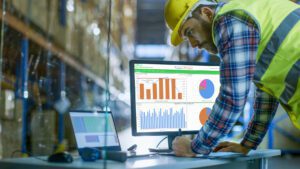Earlier this year, U.S. President Biden announced “a new target for the United States to achieve a 50-52 percent reduction from 2005 levels in economy-wide net greenhouse gas pollution in 2030.” While governments around the globe make stronger sustainability commitments, more businesses are strengthening their own. This is confirmed in a 2020 KPMG survey that found 90% of “top 100” companies in North America are now reporting on sustainability and that, at 98%, the U.S. is “among the 10 countries and jurisdictions sustainability reporting rates in the world”. In terms of hard commitments, researchers say that a fifth of the world’s largest companies are now adopting net-zero targets. But how does power monitoring support sustainability initiatives?

While sustainability is increasingly important, so is protecting profits and keeping operations running 24/7. Thankfully, there is a cost-effective solution that can help with these three challenges, supporting everyone from the top floor to shop floor. In this post, we will show how next-generation power monitoring delivers the data your organization needs to meet your sustainability commitments while realizing a fast payback from cutting energy costs and improving business resilience.
Power monitoring: helping set a profitable path to sustainability
Corporate sustainability covers many different initiatives, but let’s focus on energy-related opportunities. For example, you may want to reduce energy-related emissions to meet local regulations. This can include taking advantage of renewable energy sources, like adding solar panels and energy storage to your buildings, procuring green energy from the grid, or responding to carbon pricing. Another good step is to maximize electrification by converting any fossil-fuel-based heating to electric.
All these steps will be good for the environment, your brand image, and – especially in the case of renewables – for your bottom line. But to fully leverage each initiative, you must accurately measure how and when you are consuming each energy source throughout your facilities. A digitized electrical distribution system using networked power monitoring is the foundation for getting the data you need. You may already have networked digital power meters in place, and simply need to add a few missing pieces.
Energy data from meters need to be aggregated by an energy and power management system (EPMS), with software that converts that data into actionable insights. Your energy or sustainability manager needs a dashboard with key performance indicators that profile how each department or process is using energy. By normalizing for parameters like weather or work schedules, then benchmarking against other facilities or comparing day-to-day or year-to-year, sources of energy inefficiency or waste will quickly be revealed so you can address them.
An EPMS will also help you differentiate the energy you are consuming from the grid versus onsite renewables, onsite storage, and procured green energy. This perspective will help you maximize the use of renewables, or sell onsite energy back to the grid, only when it is most economic to do so. The best EPMS will also push data to analytics applications that calculate equivalent emissions, helping you track sustainability progress, meet regulatory requirements, and support ESG reporting.
Power monitoring is the glue that binds sustainability and efficiency
We can already see that actively managing your energy delivers multiple benefits. While reducing your carbon footprint, you can also be reducing your energy bills.
Having accurate energy and power data from a power monitoring system will also support other important cost-saving initiatives. For example, the EPMS will help you drive efficient behavior by allocating energy costs to departments or sub-billing tenants. Nothing motivates energy efficiency better than an unexpectedly large bill, whether it comes from the utility company or your internal accounting department! You can also validate your utility bills to catch any errors that originate from your electricity provider. By tracking all aspects of power performance, the EPMS will also help you better manage power factor and peak demand to avoid penalties from your utility. It will also simplify reporting for energy efficiency compliance (e.g. LEED, ISO50001).
But why stop at electricity? The best EPMS solutions offer comprehensive tracking of other utilities like water, compressed air, natural gas, and steam (WAGES). An EPMS can integrate and analyze consumption data from each of these resources throughout your operations, helping you manage all utilities in a unified way.
Using all these resources more efficiently is a further measure of a sustainable enterprise while delivering a fast return on investment from power monitoring that will boost your bottom line. But there is one more critical dimension to cover.
Improving resilience through power monitoring: avoiding the business costs of downtime
For most organizations, a power outage can be catastrophic. Every minute of downtime can represent extreme financial impacts, a loss of customer confidence, and even a risk to human life. Managing your energy use can deliver very impressive savings, but those savings can quickly dissolve if you suffer an extended period of downtime.
For this reason, hospitals, data centers, and other facilities with critical power needs have onsite backup power or even add complete microgrids to guard against grid instability due to extreme weather events. But this is not enough. You need to use power monitoring technology to track every aspect of power performance every second of the day to identify any threats to continuity.
The most advanced power meters and EPMS solutions go beyond energy management by including a wide range of power quality and reliability analytics. Operations and maintenance personnel are alerted with meaningful, prioritized alarms when power conditions exceeding predefined, safe thresholds or when a power quality event occurs. Smart analytic tools help technicians quickly identify and isolate the source of any risks, helping teams respond to a problem before an outage occurs or, in the worst case, helping them restore power as quickly as possible.
An EPMS can also help predict when power equipment or loads require maintenance. This can help avoid failures, extend lifespan, and support a transition to condition-based maintenance, saving significant time and costs.
The 750,000 square foot Guardian Glass plant in Dewitt, Iowa in the United States is using EcoStruxure Power Monitoring Expert and a network of smart power metering devices to isolate power quality events like voltage sags, helping them avoid equipment malfunctions and production downtime. Oracle Corporation headquarters in California has used EcoStruxure Power Monitoring Expert and PowerLogic advanced meters to identify and address reliability risks such as utility-side transients and under-voltage events, as well as tracking temperatures and oil levels in secondary transformers at their substation.
As you can see, achieving your sustainability goals can be done efficiently and cost-effectively. In fact, by investing in next-generation power monitoring and EPMS technologies, you will not only get a fast return on your investment, you will also be protecting your longer-term profits by operating with much greater efficiency and resilience.
For more information
As part of the EcoStruxure Power platform from Schneider Electric, PowerLogic advanced power metering devices, EcoStruxure Power Monitoring Expert software, and Resource Advisor and EcoStruxure Power Advisor services are designed as a unified energy and power management solution to help multiple teams in your organization gain deep insights and collaborate to improve the sustainability, efficiency, and resilience of your facilities. To learn more, about power monitoring and EcoStruxure Power solutions, visit the web page.



